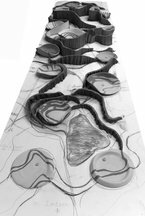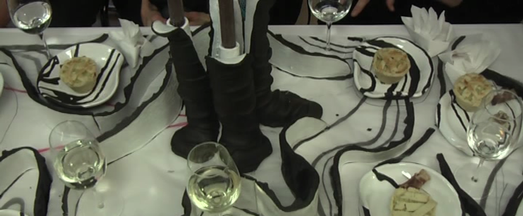The Banquet as mapping of a Region:
In the deposit of Moresnet calamine could be found in the upper layers. After 1800 by means of new developed technical procedures sphalerite could be used from the lower layers. (Source: F. Holtz www.stolberg-abc.de)
Peschke attaches importance to the specific materials of the respective region used for her artworks. As an artistic performance she creates a banquet that is built with the materials specific for a region. The banquet is decorated as a festive table on which people can sit around. It therefore conduces to a space of dialogue and interaction, where people come together and feel connected through the banquets compositional arrangement of the region. When generating the banquet, Peschke follows not only the idea about the different materials, but also reconstructs the landscape like mountains, hills, valleys, rivers and the layers of earth. Hence she emphasises on the features of a region and highlights them in a visual and creative way. By this performance Peschke wants to support the identification with its own region and at the same time encourage acceptance for other areas. Therefore, the aim is mutual respect and appreciation of every single culture to eliminate populism, because just as people cannot be compared in their value, also cultures are incommensurable.
Valeska Peschke, Amikejo Banquet, 140x70 cm, Ceramicstudio Jörg Kinzelmann, 2014
Valeska Peschke, Amikejo Banquet für den Salon Sophie Charlotte, 140x70 cm, Höhenlinien und Schalen aus schwarzer Keramik mit weisser Glasur, Akademie der Wissenschaften Berlin, Performance with Robert Menasse, Ulrike Guérot, and friends 2014
The constellation of all regions in the shape of a crystal
Part of the project is also a reconstruction of the form of Moresnet which is similar to the form of a splitter or crystal. This reconstruction in the shape of a crystal should represent each European region visited in essence and artistically. Eventually, all the different crystals ought to symbolise the European Republic; in diversity and yet as a united, joint Europe. Peschke entitles her project “Crystal of Cultures” or “kulturo Kristalo” which is Esperanto. So the prism stands for identification and uniqueness of each region, for the abundance of various values, tradition and culture in general. However, nothing is set in stone. Identification means continuous reinterpretation of facts and circumstances and therefore also a constant redefinition of one’s own being. Valeska Peschke wants to make space and time in which things happen and develop continually, a space of being and not-being.
The mission of Amikejo is traveling
The prism is located on a truck, designed by Valeska Peschke. This truck is signifying the mission of Amikejo and its whole idea behind it. Its external cladding shows zinc and minerals from all regions e.g. zinc from Kelmis, the place of friendship “Amikejo”. Instead of always looking for mineral resources, these resources now make a trip across Europe, looking for cultural treasures. Peschke’s concept of this performance is the shift of values; away from the treasures of the soil that are occupied by different nations and controlling the economy and world affairs. We rather need to focus on cultural assets that are essential and necessary for a healthy development of human’s personality and identification. Peschke’s art is aiming to make people aware of and to put a focus on their creativity and actual needs. A better understanding of one’s own culture and honest recognition and appreciation of every other culture would eliminate or at least diminish the competition between nations and the pressure to be economically always more successful than others. A transparent crystalline margin, which layout refers to the shape of Amikejo, shows the identity and essential characteristics of a region and its citizens. In the inside of the truck there is a so called “Salon of Diplomacy” with an Esperanto table, a consulate with a counter and a desk for a non-material object of the future. In regards to the cartographical layout of Moresnet and its surrounding area in the shape of a triangle, Peschke created a ceramic for the “Salon of the Mission” that can be adapted to any other area and region. The ceramic takes up the topics of landscape and contour lines and is part of the banquet.
The "probe" as a symbol of transnational dialogue:
Finally, the project includes a so called “probe”, a symbol of mobility and exchange. The probe is an inflatable construction, made out of vinyl and textile. First looking like a stone, it then unfolds itself to a sofa with printed minerals and golden roof. It conduces to communication and meeting and stands for physical as also psychical mobility. Due to its portability, the sofa and its users are always in motion, changing their positions. Moreover, because the probe is also suitable for outdoor space, there are neither spatial nor mental boundaries.
Copyright © All Rights Reserved Idea & Concept & Art by Valeska Peschke, Berlin 2017




